It is good practice for organisations to regularly think strategically about where they want to be, what they want the organisation to look like, and how they need to go about getting there. Traditionally, this process happened on an annual basis and was largely integrated with the annual financial planning process. With more and more organisations moving to become more agile, strategic planning and delivery is becoming a more continuous process, leading to a flood of new ideas and projects all contending for the same pool of money and resources. And to add to this, things seem to evolve and change on a daily basis, requiring the organisation to frequently check and validate that the priorities of yesterday, are still relevant and viable today.
What is prioritisation?
Prioritisation is about ranking ideas, demand, proposals or projects within a portfolio using an agreed technique or set of measures in order to help Senior Executives and/or Portfolio Governing Bodies answer the following questions:
-
- Which ideas or projects should we invest in now?
- Which projects must be resourced above all others?
- Which projects are the most important to get us where we want to be?
- Which set of projects will cover all our strategic objectives?
The key purpose of prioritisation is to ensure that every level within the organisation is aligned and focused on the strategic objectives and to clear any doubts that may arise on a day-to-day basis, ensuring that operational teams are always focused on the most critical projects first.
There are many different stakeholders involved in the delivery of projects and all these stakeholders are likely to have differing opinions about which projects should be handled first. However, by implementing a clearly defined prioritisation process and using an acceptable prioritisation technique, the process can be much more transparent, effective and efficient.
When to use prioritisation?
Organisations have limited resources (people and money). There is only so much time in a day to get the work done, and there is only so much change that the people within business can deal with in a given period of time. As much as an organisation would like to pursue every opportunity and idea that can potentially add value to its current operations and future aspirations, there is only so much it can realistically do and invest in. This is when prioritisation becomes critical, i.e. when it needs to decide which ideas to move into the portfolio of projects. But, this is not the only time. Things can change significantly as projects move through its lifecycle. It is therefore necessary to regularly review the priorities and to potentially reprioritise the portfolio, when specific events occur, such as:
- Significant cost and time overruns outside agreed tolerances;
- Resources allocation conflicts and issues;
- Internal changes, such as mergers and acquisitions or a change in strategy; and
- External changes, such as changes in market and economic conditions.
What do you need to consider?
There are a few key things that you need to consider when implementing prioritisation:
- Prioritisation is not easy. It requires stakeholders to have an open mind about what is best for the organisation as a whole, rather than a specific business area or function;
- It requires access to up-to-date and accurate data. An essential tool that is critical for prioritisation is the business case. Organisations may call it different things but it is essentially the document that includes key information such as strategic contribution, business reason, cost and benefits, all the data that is important to establish priority;
- Categorisation of ideas and projects is important as it assists with strategic alignment, appraisal and prioritisation, and ultimately ensures that the organisation has a “balanced portfolio” of initiatives, i.e. it covers all strategic objectives. Some examples of categories are: Regulatory, New Product, New Technology, Efficiency;
- Prioritisation is not a once-off exercise. The first time you are likely to prioritise is when a decision is required to further analyse an idea or to initiate a project. However, prioritisation should be done on an ongoing basis on the active portfolio to ensure projects remain strategically aligned and have continued justification. Business cases should therefore be continuously updated throughout the lifecycle and at key points to enable a regular review of priorities;
- Although an objective approach to prioritisation (such as a scoring model) can help Senior Executives and/or Portfolio Governing Bodies make more informed, consistent and transparent decisions, it is not a replacement for management judgement; and
- Sophisticated approaches are not necessarily more reliable than simple ones.
What techniques can you use?
There are three prioritisation techniques that we have found extremely useful when it comes to prioritisation:
-
- Forced Ranking;
- Paired Comparison; and
- Weighted Scoring Models.
Forced Ranking and Paired Comparison are simple techniques that can easily be implemented when an organisation is considering prioritisation for the first time. It is especially useful when key information required for scoring is not yet available (e.g. when business cases are not available for all ideas or projects) and/or when Senior Executives are not ready for a weighted scoring model. This then also gives the organisation time to get the relevant buy-in and information in place to move to a scoring model, if needed.
Forced Ranking
With Forced Ranking, a group of Executives/Experts independently rank all the projects under consideration giving them numerical values 1, 2, 3 and so on starting from the most attractive one. For each project, the rankings from each member of the group are added and the projects are re-ranked with the lowest score attracting the highest ranking (as illustrated below).
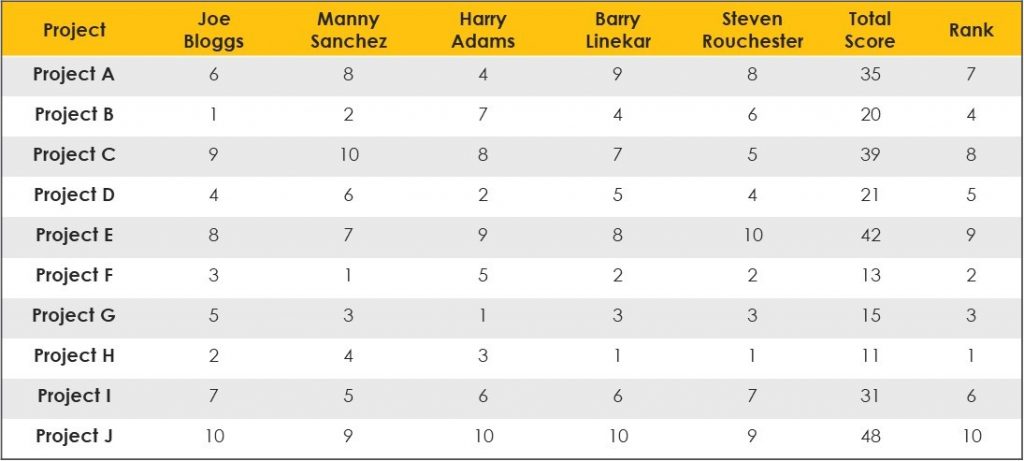
Paired Comparison
In this method, every project is compared with every other project as a pair. The better project between the two under consideration receives a score of 1 while the other gets a 0. The scores for each project are then added and the project with the highest score is ranked as No.1, as illustrated below. This approach is of most value when it is derived from a facilitated, open debate by Senior Executives on, for example, is Project A more or less strategically important than Project B? Not only does this ensure a strategically aligned portfolio, but it also builds commitment and support to deliver the portfolio.
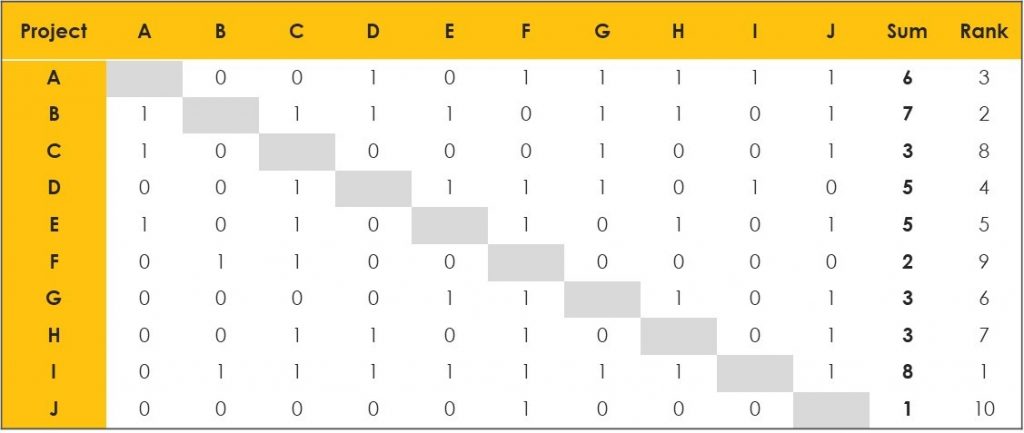
Weighted Scoring Model
A weighted scoring model includes key criteria that has each been assigned a weighting (importance) as well as a list of ratings for each criterion, i.e. a way of assessing a low, medium, or high score. When using a weighted scoring model, it is good practice to use multi-criteria analysis as financial metrics only can constrain investments in efficiency initiatives (e.g. technology infrastructure projects) as the financial return is not immediately obvious.
Three key things to bear in mind when using a weighted scoring model include:
- Each project category should have its own prioritisation criteria to ensure that there is a level playing field;
- Scores allocated to each criterion should be validated through evidence-based assessments (a key role that the PMO can play) to provide stakeholders with the confidence that all initiatives have been equally appraised;
- The Portfolio Management Board/Investment Committee (or similar governing body) should provide input and agree to the prioritisation criteria and weightings as they are the key decision makers regarding the final prioritised list.
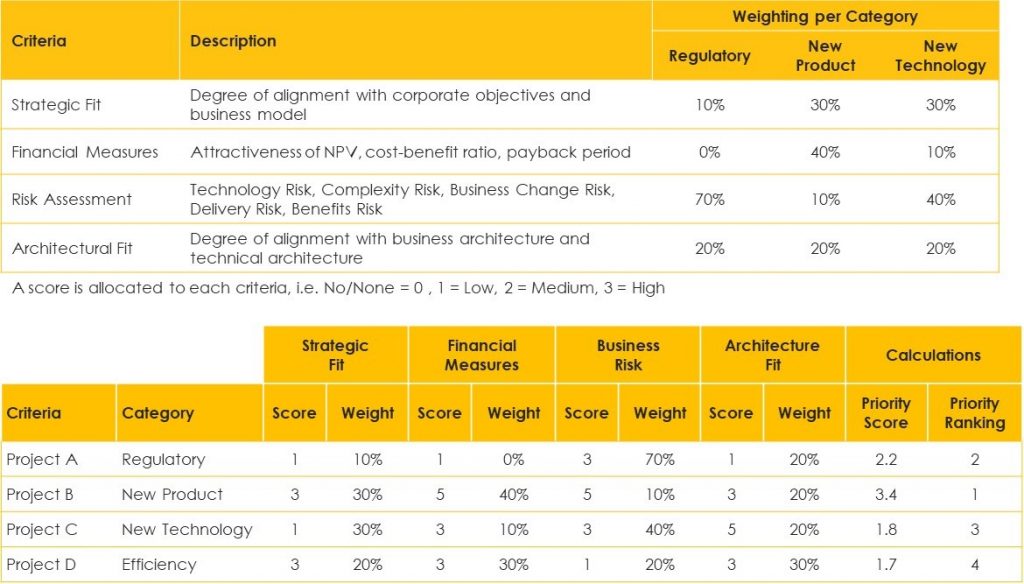
Before implementing a scoring model, it may be a good idea to get Executives to force rank a sample set of active projects (5 or 10 projects) and to test the scoring model on the same sample set to see if the same outcome is more or less achieved.
How to go about implementing a weighted scoring model?
The diagram below illustrates a simple process to follow when implementing a weighted scoring model for the first time.

The key steps are:
-
-
-
- Decide on the prioritisation criteria that represent the factors that your organisation views as most important when considering an idea or project;
- Agree the importance of each criteria by assigning a weighting or percentage of relevant importance. Agree a rating or scoring system per category to apply to the initiatives;
- Rate each initiative using the ratings and weightings identified;
- Collate all prioritisation information into a ranked list and analyse. The information can also be represented in a simple bubble matrix; and
- Prioritise the initiatives and communicate the outcome in a portfolio map or delivery plan.
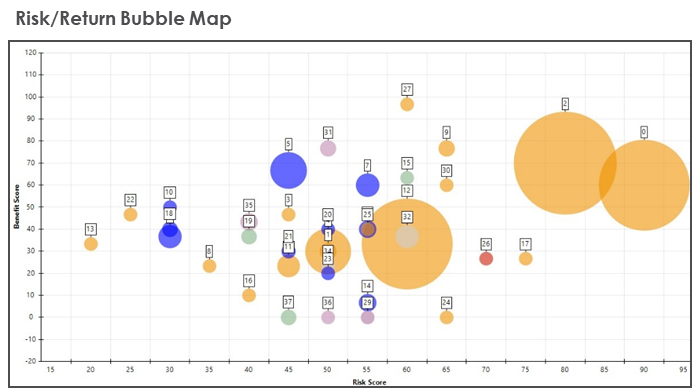
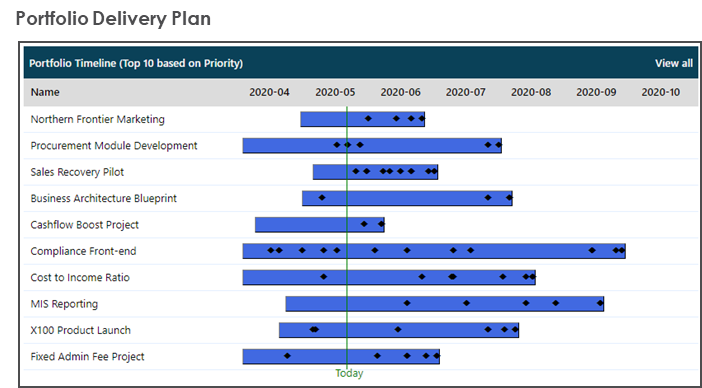
So we’ve prioritised the projects…..now what?
Once projects or initiatives have been ranked using one of the techniques above, the next important step is for key decision makers to discuss the outcome and select a portfolio of projects that is affordable, achievable and balanced. A prioritisation dashboard is another useful tool that can be used in conjunction with the portfolio dashboard to facilitate the right discussions.
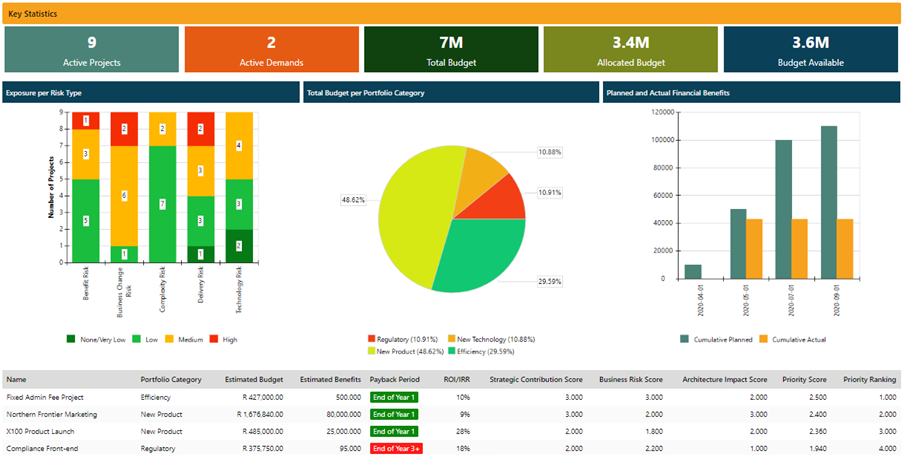
Some of the key questions that Senior Executives and/or Portfolio Governing Bodies should consider at this point are:
- Which set of projects can we realistically execute within the specified timeframe, given their demand for and our supply of key resources? Should we acquire additional resources?
- Will business have the capacity to absorb all the changes that these projects will bring about? Should we change the timing/scheduling so that a manageable spread is achieved?
- Are we covering all our strategic objectives? Do we need to adjust the selection of projects or our strategic objectives to match what is achievable and affordable?
- Are we taking on too much risk? Is the overall risk exposure across the portfolio of projects at an acceptable level, considering the return expected?
The PMO plays a critical role in this step as it needs to provide decision makers with the necessary reports, analysis and recommendations to answer the questions above and to ultimately ensure that the portfolio of projects selected is executable and balanced.
Once the portfolio has been agreed, it is also the responsibility of the PMO to translate this into an overall portfolio strategy and delivery plan for company-wide communication and that will also provide the baseline against which portfolio performance and progress is tracked and reported using a portfolio dashboard report.
Prioritisation brings clarity and alignment
The process of prioritisation can be challenging and frustrating but is an important step towards improving project success and for realising an organisation’s strategy. It involves a variety of stakeholders, all with their own focus areas and opinions. By taking the time to go through this process on a regular basis, the organisation can ensure alignment, clear expectations and transparency across all levels. With PPO’s prioritisation entity, you have the ability to choose the technique that is a best-fit for your organisation and to tailor it to suit your stakeholder’s specific requirements.
To learn more about how you can set-up prioritisation models within PPO click here.
-
-


